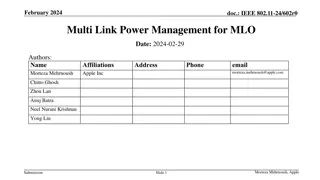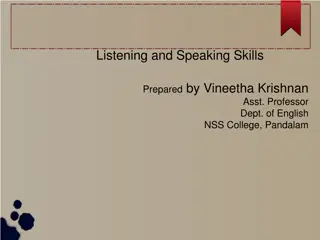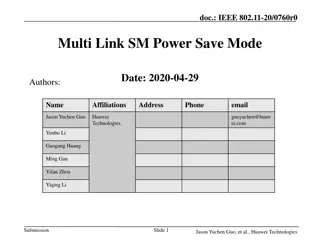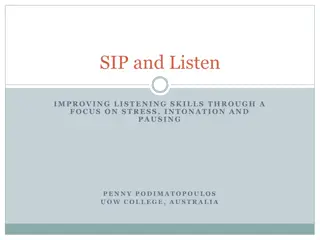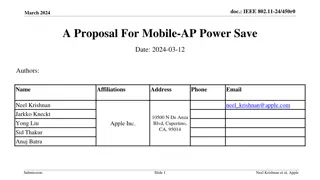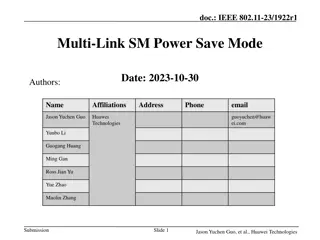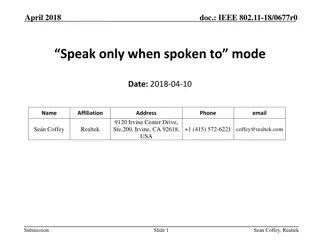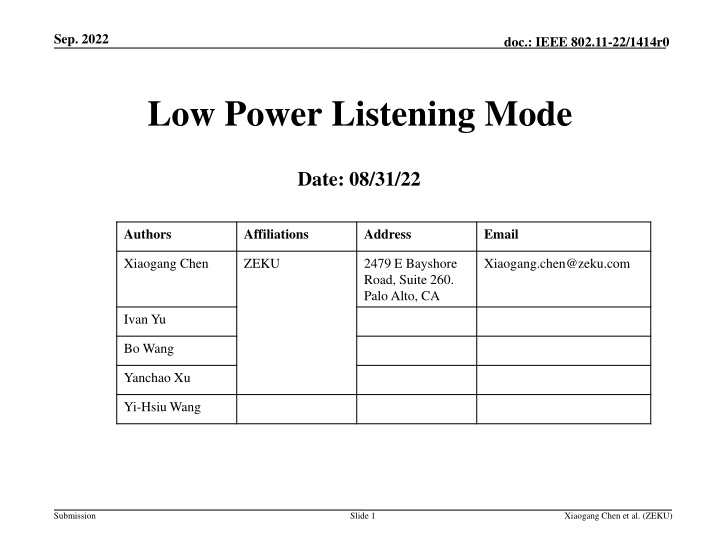
Enhancing Wi-Fi Power Efficiency in Next-Gen Devices
Explore the analysis of Wi-Fi power consumption and potential improvements in IEEE 802.11 standards to optimize device-level power consumption in next-gen smartphones. The study group aims to enhance reliability, reduce latencies, increase manageability, throughput, and minimize power usage in devices with multiple integrated radios. Testing on different apps and scenarios was conducted to evaluate power consumption in listening modes.
Download Presentation

Please find below an Image/Link to download the presentation.
The content on the website is provided AS IS for your information and personal use only. It may not be sold, licensed, or shared on other websites without obtaining consent from the author. If you encounter any issues during the download, it is possible that the publisher has removed the file from their server.
You are allowed to download the files provided on this website for personal or commercial use, subject to the condition that they are used lawfully. All files are the property of their respective owners.
The content on the website is provided AS IS for your information and personal use only. It may not be sold, licensed, or shared on other websites without obtaining consent from the author.
E N D
Presentation Transcript
Sep. 2022 doc.: IEEE 802.11-22/1414r0 Low Power Listening Mode Date: 08/31/22 Authors Affiliations Address Email Xiaogang Chen ZEKU 2479 E Bayshore Road, Suite 260. Palo Alto, CA Xiaogang.chen@zeku.com Ivan Yu Bo Wang Yanchao Xu Yi-Hsiu Wang Submission Slide 1 Xiaogang Chen et al. (ZEKU)
Sep. 2022 doc.: IEEE 802.11-22/1414r0 Outline Background Listening mode power consumption Power consumptions break down Low Power Listening (LPL) Power consumption comparisons; Considerations on the existing listening modes; Potential improvements in the standards. Summary Submission Slide 2 Xiaogang Chen et al. (ZEKU)
Sep. 2022 doc.: IEEE 802.11-22/1414r0 Background Device level power consumption was set as a KPI to optimize in the next gen: The Study Group will investigate technology which may improve reliability of WLAN connectivity, reduce latencies, increase manageability, increase throughputincluding at different SNR levels, and reduce device level power consumption Smartphones are becoming more powerful but also suffering from power consumptions due to more radios being integrated: cellular, Wi-Fi, BT, GNSS, UWB; Wi-Fi power consumption is analyzed in this contribution. Submission Xiaogang Chen et al. (ZEKU)
Sep. 2022 doc.: IEEE 802.11-22/1414r0 Listening mode power consumptions (1/2) Two commercial phones (different models on the Apps Sleep Listen TX RX Time percentage(%) Power percentage(%) Time percentage(%) Power percentage(%) Time percentage(%) Power percentage(%) Time percentage(%) Power percentage(%) Time percentage(%) Power percentage(%) Time percentage(%) Power percentage(%) Time percentage(%) Power percentage(%) Time percentage(%) Power percentage(%) Time percentage(%) Power percentage(%) Time percentage(%) Power percentage(%) Time percentage(%) Power percentage(%) Time percentage(%) Power percentage(%) Time percentage(%) Power percentage(%) Time percentage(%) Power percentage(%) Time percentage(%) Power percentage(%) 71.48 2.78 39.10 0.73 53.33 1.04 65.64 1.80 43.32 0.83 68.50 2.68 60.68 1.81 64.71 2.10 67.14 2.05 53.27 1.28 75.35 3.12 59.60 1.50 61.50 1.46 88.55 7.62 59.78 1.64 24.67 62.68 54.20 65.83 40.38 51.40 28.11 50.51 49.42 62.15 29.50 75.42 34.52 67.47 31.79 67.40 25.64 51.17 40.60 63.76 19.67 53.18 35.30 58.25 31.20 48.48 9.88 55.58 34.83 62.43 0.18 6.64 0.66 11.63 1.61 29.74 0.68 17.73 0.67 12.23 0.24 8.90 0.12 3.40 0.34 10.46 0.16 4.63 0.34 7.75 0.11 4.32 0.80 19.16 0.90 20.30 0.16 13.06 0.34 8.84 3.67 27.90 6.00 21.80 4.68 17.82 5.57 29.95 6.59 24.79 1.70 13.00 4.67 27.31 3.16 20.04 7.06 42.15 5.79 27.21 4.87 39.39 4.27 21.08 6.40 29.76 1.41 23.73 5.05 27.08 Video_1 higher end) are used in testing; 11ax is supported on both AP and STA; Video_2 Video_3 Testing was conducted for ~24 hours for each Video_4 APP; Shopping_1 Shopping_2 Every app has predefined operations in testing Message_1 which is believed to mimic the daily usage. Message_2 Browser_1 Note: Browser_2 Rx: Receiver needs to parse individual addressed or group addressed Gaming packets; Music Listen: Waiting for packet. News Standby Average Submission Xiaogang Chen et al. (ZEKU)
Sep. 2022 doc.: IEEE 802.11-22/1414r0 Listening mode power consumptions (2/2) Listening mode contributes considerable amount of time overall. Listening mode contributes more than half of the power consumption in testing. Note: Sleep mode is also important but may not fit the bill for all applications. Sleep mode can be another direction to optimize for low power. Submission Xiaogang Chen et al. (ZEKU)
Sep. 2022 doc.: IEEE 802.11-22/1414r0 Power consumptions break down (1/2) PLL and ADC contribute majority of the power consumptions in the RF. Stringent Rx EVM requirements for 4KQAM raise the power consumption of PLL; Larger BW also push for ADC power consumption. Modules 160MHz 20MHz 2 Chain 1 Chain 2 Chain 1 Chain PLL 25% 40% 40% 55% ADC 24% 18% 7% 5% Others (LNA, LO, LPF, etc.) 51% 42% 53% 40% Total 100% 100% 100% 100% Note 1: Power consumption is normalized per column. Note 2: Power consumption is measured on commercial platform. Submission Xiaogang Chen et al. (ZEKU)
Sep. 2022 doc.: IEEE 802.11-22/1414r0 Power consumptions break down (2/2) If LPL (Low Power Listening) module is introduced in RF, the power consumption will be scaled down as in the table below: Significant amount of power consumption can be saved in RF with a dedicated LPL mode. 160MHz HP 20MHz HP 20MHz LP 2 Chain 2 Chain 1 Chain PLL 100% 100% 7% ADC 100% 19% 3% Others 100% 66% 14% Total 100% 63% 9% Note: Normalized per row based on 160MHz HP Submission Slide 7 Xiaogang Chen et al. (ZEKU)
Sep. 2022 doc.: IEEE 802.11-22/1414r0 Considerations on LPL (1/3) Standardized solution: SMPS SISO MIMO RTS/Trigger PPDU AP SMPS CTS BA STA False trigger: Non-AP STA cannot differentiate regular RTS/Trigger from the RTS/Trigger used to wake up the 2nd chain. With the large power consumption from the PLL, disable one chain doesn t provide significant power saving anymore. 160MHz 20MHz 2 Chain 1 Chain 2 Chain 1 Chain Total Power consumption (Normalized by 2 Chian) 100% 65% 100% 73% Saving with 1 chain off 35% 27% Submission Xiaogang Chen et al. (ZEKU)
Sep. 2022 doc.: IEEE 802.11-22/1414r0 Considerations on LPL (2/3) Standardized solution: EMLSR For a specific device category instead of a generic solution. STA support STR cannot leverage EMLSR on each link independently. Flexible to implementation. Can be considered as a starting point to extend. LowPwr Listen LowPwr Listen 1 RF chain, 20MHz, up to 24Mbps 1 RF chain, 20MHz, up to 24Mbps MU-RTS Link 1 PPDU AP CTS BA STA LowPwr Listen LowPwr Listen 1 RF chain, 20MHz, up to 24Mbps 1 RF chain, 20MHz, up to 24Mbps Doze MU-RTS Link 2 AP STA CTS Submission Xiaogang Chen et al. (ZEKU)
Sep. 2022 doc.: IEEE 802.11-22/1414r0 Considerations on LPL (3/3) Dedicated low power listening module based on implementation Example: Introducing a 20MHz LPL chain brings the power consumption down to 10%- 20% relative to the regular power consumptions in RF (page 7). Further saving is feasible if baseband is also optimized for listening. Challenge is the settling time of RF (PLL). Standardization can provide more flexibilities to the implementation. Example 1 LowPwr HighPwr LowPwr RTS/Trigger Pre-EHT field EHT modulated field AP CTS BA PPDU Up to 320MHz 4kQAM STA Example 2 LowPwr HighPwr LowPwr Submission Xiaogang Chen et al. (ZEKU)
Sep. 2022 doc.: IEEE 802.11-22/1414r0 Standardization for LPL All the existing listening modes (SMPS, EMLSR) are combination of standardization and implementation. Potential improvements in standard During listening (initial frame exchange), provides more & accurate information for the coming PPDU which require high power processing: Number of spatial streams will help HP (high power) Rx to decide how many chains to power on; Bandwidth will help HP Rx to fine tune ADC/others to avoid unnecessary oversampling; MCS will help HP Rx to determine the required EVM on the Rx side. Configurable Padding in the initial frame exchange provides flexibility for Rx to tradeoff between power consumption and latency/efficiency. Submission Xiaogang Chen et al. (ZEKU)
Sep. 2022 doc.: IEEE 802.11-22/1414r0 Summary Standardization aided listening mode is highly recommended for the next gen. A simplified version can be considered for Wi-Fi7. Recommend to define a listening mode with reasonable complexity that can be mandatory supported by the AP. Submission Xiaogang Chen et al. (ZEKU)



